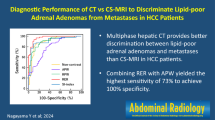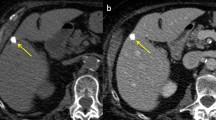Abstract
Objective
To compare the classification based on contrast-enhanced ultrasound (CEUS) Liver Imaging Reporting and Data System (LI-RADS) with that of contrast-enhanced CT and MRI (CECT/MRI) LI-RADS for liver nodules in patients at high risk of hepatocellular carcinoma.
Methods
Two hundred thirty-nine patients with 273 nodules were enrolled in this retrospective study. Each nodule was categorized according to the CEUS LI-RADS version 2017 and CECT/MRI LI-RADS version 2017. The diagnostic performance of CEUS and CECT/MRI was compared. The reference standard was histopathology diagnosis. Inter-modality agreement was assessed with Cohen’s kappa.
Results
The inter-modality agreement for CEUS LI-RADS and CECT/MRI LI-RADS was fair with a kappa value of 0.319 (p < 0.001). The positive predictive values (PPVs) of hepatocellular carcinoma (HCC) in LR-5, LR-4, and LR-3 were 98.3%, 60.0%, and 25.0% in CEUS, and 95.9%, 65.7%, and 48.1% in CECT/MRI, respectively. The sensitivities and specificities of LR-5 for diagnosing HCC were 75.6% and 93.8% in CEUS, and 83.6% and 83.3% in CECT/MRI, respectively. The positive predictive values of non-HCC malignancy in CEUS LR-M and CECT/MRI LR-M were 33.9% and 93.3%, respectively. The sensitivity, specificity, and accuracy for diagnosing non-HCC malignancy were 90.9%, 84.5%, and 85.0% in CEUS LR-M and 63.6%, 99.6%, and 96.7% in CECT/MRI LR-M, respectively.
Conclusions
The inter-modality agreement of the LI-RADS category between CEUS and CECT/MRI is fair. The positive predictive values of HCCs in LR-5 of the CEUS and CECT/MRI LI-RADS are comparable. CECT/MRI LR-M has better diagnostic performance for non-HCC malignancy than CEUS LR-M.
Key Points
• The inter-modality agreement for the final LI-RADS category between CEUS and CECT/MRI is fair.
• The LR-5 of CEUS and CECT/MRI LI-RADS corresponds to comparable positive predictive values (PPVs) of HCC. For LR-3 and LR-4 nodules categorized by CECT/MRI, CEUS examination should be performed, at least if they can be detected on plain ultrasound.
• CECT/MRI LR-M has better diagnostic performance for non-HCC malignancy than CEUS LR-M. For LR-M nodules categorized by CEUS, re-evaluation by CECT/MRI is necessary.




Similar content being viewed by others
Abbreviations
- ACR:
-
American College of Radiology
- APHE:
-
Arterial phase hyperenhancement
- CECT:
-
Contrast-enhanced computerized tomography
- CEUS:
-
Contrast-enhanced ultrasound
- CHC:
-
Combined hepatocellular cholangiocarcinoma
- CPS/CHI:
-
Contrast pulse sequencing/contrast high-resolution imaging
- EOB-MRI:
-
Gadoxetic acid–enhanced magnetic resonance imaging
- FN:
-
False negative
- FP:
-
False positive
- HCC:
-
Hepatocellular carcinoma
- HGDN:
-
High-grade dysplastic nodule
- ICC:
-
Intrahepatic cholangiocarcinoma
- LGDN:
-
Low-grade dysplastic nodule
- LI-RADS:
-
Liver Imaging Reporting and Data System
- LR:
-
Likelihood ratio
- M:
-
Metastases
- NPV:
-
Negative predictive value
- PI:
-
Pulse inversion imaging
- PPV:
-
Positive predictive value
- RN:
-
Regenerative nodule
- TN:
-
True negative
- TP:
-
True positive
References
Lyshchik A, Kono Y, Dietrich CF et al (2018) Contrast-enhanced ultrasound of the liver: technical and lexicon recommendations from the ACR CEUS LI-RADS working group. Abdom Radiol (NY) 43:861–879
Mitchell DG, Bruix J, Sherman M, Sirlin CB (2015) LI-RADS (Liver Imaging Reporting and Data System): summary, discussion, and consensus of the LI-RADS Management Working Group and future directions. Hepatology 61:1056–1065
Seitz K, Bernatik T, Strobel D et al (2010) Contrast-enhanced ultrasound (CEUS) for the characterization of focal liver lesions in clinical practice (DEGUM Multicenter Trial): CEUS vs. MRI–a prospective comparison in 269 patients. Ultraschall Med 31:492–499
Guang Y, Xie L, Ding H, Cai A, Huang Y (2011) Diagnosis value of focal liver lesions with Sonovue-enhanced ultrasound compared with contrast-enhanced computed tomography and contrast-enhanced MRI: a meta-analysis. J Cancer Res Clin Oncol 137:1595–1605
Kono Y, Lyshchik A, Cosgrove D et al (2017) Contrast enhanced ultrasound (CEUS) liver imaging reporting and data system (LI-RADS): the official version by the American College of Radiology (ACR). Ultraschall Med 38:85–86
Wilson SR, Lyshchik A, Piscaglia F et al (2018) CEUS LI-RADS: algorithm, implementation, and key differences from CT/MRI. Abdom Radiol (NY) 43:127–142
Schellhaas B, Hammon M, Strobel D et al (2018) Interobserver and intermodality agreement of standardized algorithms for non-invasive diagnosis of hepatocellular carcinoma in high-risk patients: CEUS-LI-RADS versus MRI-LI-RADS. Eur Radiol 28:4254–4264
Kim TK, Noh SY, Wilson SR et al (2017) Contrast-enhanced ultrasound (CEUS) liver imaging reporting and data system (LI-RADS) 2017-a review of important differences compared to the CT/MRI system. Clin Mol Hepatol 23:280–289
Kambadakone AR, Fung A, Gupta RT et al (2018) LI-RADS technical requirements for CT, MRI, and contrast-enhanced ultrasound. Abdom Radiol (NY) 43:56–74
Terzi E, Iavarone M, Pompili M et al (2018) Contrast ultrasound LI-RADS LR-5 identifies hepatocellular carcinoma in cirrhosis in a multicenter restropective study of 1,006 nodules. J Hepatol 68:485–492
Zheng W, Li Q, Zou XB et al (2019) Evaluation of contrast-enhanced US LI-RADS version 2017: application on 2020 liver nodules in patients with hepatitis B infection. Radiology 294:299–307
Van der Pol CB, Lim CS, Sirlin CB et al (2019) Accuracy of the Liver Imaging Reporting and Data System in computed tomography and magnetic resonance image analysis of hepatocellular carcinoma or overall malignancy-a systematic review. Gastroenterology 156:976–986
Terzi E, De Bonis L, Leoni S, Benevento F, Granito A, Tovoli F (2017) CEUS LI-RADS are effective in predicting the risk hepatocellular carcinoma of liver nodules. Dig Liver Dis 49:e22
Mitchell DG, Bashir MR, Sirlin CB (2017) Management implications and outcomes of LI-RADS-2, -3, -4, and -M category observations. Abdom Radiol (NY) 43:143–148
Piscaglia F, Wilson SR, Lyshchik A et al (2017) American College of Radiology, contrast enhanced ultrasound liver imaging reporting and data system (CEUS LI-RADS) for the diagnosis of hepatocellular carcinoma: a pictorial essay. Ultraschall Med 38:320–324
Ding J, Zhou Y, Wang Y, Zhou H, Jing X (2017) Clinical value of contrast enhanced ultrasound in differential diagnosis of early hepatocellular carcinoma and dysplastic nodules. Adv Ultrasound Diagn Ther 1:14–20
Li F, Li Q, Liu Y et al (2020) Distinguishing intrahepatic cholangiocarcinoma from hepatocellular carcinoma in patients with and without risks: the evaluation of the LR-M criteria of contrast-enhanced ultrasound liver imaging reporting and data system version 2017. Eur Radiol 30:461–470
Kim YY, Kim MJ, Kim EH, Roh YH, An C (2019) Hepatocellular carcinoma versus other hepatic malignancy in cirrhosis: performance of LR-RADS version 2018. Radiology 291:72–80
Narsinh KH, Cui J, Papadatos D, Sirlin CB, Santillan CS (2018) Hepatocarcinogenesis and LI-RADS. Abdom Radiol (NY) 43:158–168
Yang D, Li R, Zhang XH et al (2018) Perfusion characteristics of hepatocellular carcinoma at contrast-enhanced ultrasound: influence of the cellular differentiation, the tumor size and the underlying hepatic condition. Sci Rep 8:4713
Feng Y, Qin XC, Luo Y, Li YZ, Zhou X (2015) Efficacy of contrast-enhanced ultrasound washout rate in predicting hepatocellular carcinoma differentiation. Ultrasound Med Biol 41:1553–1560
Lee HS, Kim MJ, An C (2018) How to utilize LR-M features of the LI-RADS to improve the diagnosis of combined hepatocellular-cholangiocarcinoma on gadoxetate-enhanced MRI? Eur Radiol 29:2408–2416
Acknowledgments
The present work was supported by Tianjin Science and Technology Project (No. 17ZXMFSY00050) and Tianjin Science and Technology Project (No. 17ZXMFSY00170).
Funding
The authors state that this work has not received any funding.
Author information
Authors and Affiliations
Corresponding authors
Ethics declarations
Guarantor
The scientific guarantor of this publication is Xiang Jing.
Conflict of interest
The authors of this manuscript declare no relationships with any companies, whose products or services may be related to the subject matter of the article.
Statistics and biometry
No complex statistical methods were necessary for this paper.
Informed consent
Written informed consent was waived by the Institutional Review Board.
Ethical approval
Institutional Review Board approval was obtained.
Methodology
• retrospective
• diagnostic or prognostic study
• performed at one institution
Additional information
Publisher’s note
Springer Nature remains neutral with regard to jurisdictional claims in published maps and institutional affiliations.
Rights and permissions
About this article
Cite this article
Ding, J., Long, L., Zhang, X. et al. Contrast-enhanced ultrasound LI-RADS 2017: comparison with CT/MRI LI-RADS. Eur Radiol 31, 847–854 (2021). https://doi.org/10.1007/s00330-020-07159-z
Received:
Revised:
Accepted:
Published:
Issue Date:
DOI: https://doi.org/10.1007/s00330-020-07159-z




